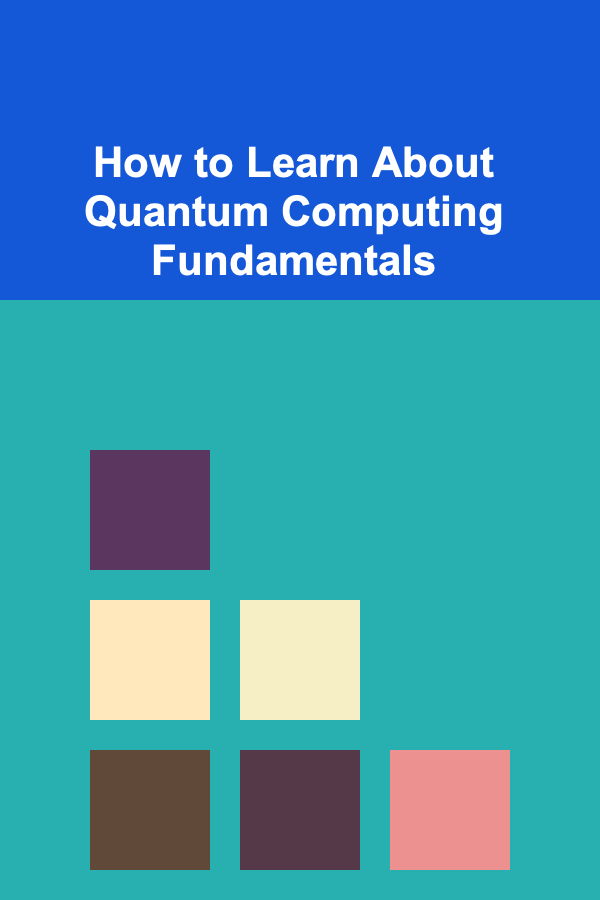
How to Learn About Quantum Computing Fundamentals
ebook include PDF & Audio bundle (Micro Guide)
$12.99$10.99
Limited Time Offer! Order within the next:

Quantum computing is an exciting and rapidly growing field that has the potential to revolutionize the way we process information. Unlike classical computing, which relies on bits that represent either a 0 or a 1, quantum computing uses quantum bits, or qubits, which can represent and process information in ways that are exponentially more powerful. However, understanding the fundamentals of quantum computing requires a strong grasp of concepts in quantum mechanics, computer science, and mathematics. This article will guide you through the essential steps to learning about quantum computing, from the foundational theories to practical applications.
Understanding the Basics of Quantum Mechanics
Before delving into quantum computing, it's crucial to have a basic understanding of quantum mechanics, the science that underpins the entire field. Quantum mechanics is the branch of physics that deals with phenomena at very small scales, such as atoms and subatomic particles. The key concepts in quantum mechanics that you need to know for quantum computing include superposition, entanglement, and quantum interference.
1.1 Superposition
Superposition is the principle that a quantum system can exist in multiple states simultaneously. In classical computing, a bit can be either a 0 or a 1. However, a qubit can be both 0 and 1 at the same time, which allows quantum computers to process a vast amount of information simultaneously. This phenomenon is similar to the idea of a coin spinning in the air -- while it is spinning, it can be considered both heads and tails until it lands and "collapses" into one state.
1.2 Entanglement
Entanglement is another key concept in quantum mechanics that plays a crucial role in quantum computing. When two qubits become entangled, their states are no longer independent. Changes made to one qubit will instantaneously affect the other, even if they are far apart. This phenomenon enables quantum computers to perform certain computations much more efficiently than classical computers.
1.3 Quantum Interference
Quantum interference occurs when the probabilities of different quantum states combine. Interference can amplify the likelihood of certain outcomes and cancel out others. In quantum computing, this property is used to guide computations toward the correct solution, allowing quantum algorithms to find answers faster than classical counterparts.
Learn the Key Mathematical Concepts
Quantum computing requires a strong understanding of linear algebra, probability theory, and complex numbers. These mathematical tools are essential for understanding how qubits interact, how quantum algorithms are constructed, and how quantum systems behave. Below are some of the key mathematical concepts that you need to master.
2.1 Linear Algebra
Linear algebra is fundamental to quantum computing. The state of a quantum system is represented by a vector in a complex vector space, and quantum operations are represented by matrices that act on these vectors. Key concepts include:
- Vectors and Matrices: In quantum mechanics, states are described using vectors, and quantum operations are described by matrices that transform these vectors.
- Eigenvalues and Eigenvectors: The measurement of a quantum state often involves finding the eigenvalues of a matrix, which represent the possible outcomes of a quantum measurement.
- Inner Product: The inner product between two quantum states is used to compute the probability of one state transitioning to another.
2.2 Probability Theory
Quantum computing is inherently probabilistic, meaning that the outcomes of computations are not deterministic but probabilistic. Probability theory helps explain how the probability amplitudes of quantum states determine the likelihood of measuring a particular outcome.
- Probability Amplitudes: Quantum states are described by probability amplitudes, which determine the likelihood of different measurement outcomes. These amplitudes are complex numbers, and the square of their absolute value gives the probability of a particular measurement result.
2.3 Complex Numbers
Quantum mechanics often deals with complex numbers, which consist of a real and an imaginary part. Complex numbers are essential in representing quantum states, as they can encode more information than real numbers alone. Understanding operations like addition, multiplication, and the use of complex conjugates is crucial for quantum computing.
Dive Into Quantum Computing Concepts
Once you have a grasp of the fundamentals of quantum mechanics and mathematics, you can begin learning the specific concepts of quantum computing. These concepts will provide a bridge between quantum mechanics and practical applications in computing.
3.1 Qubits and Quantum Gates
At the heart of quantum computing is the qubit, the quantum analog of a classical bit. Unlike classical bits, which can be either 0 or 1, qubits can exist in superposition, where they are both 0 and 1 simultaneously. Qubits can also be entangled with one another, allowing them to share information in ways that classical bits cannot.
-
Qubits : A qubit is represented as a two-dimensional vector in a complex vector space. It is usually denoted as ∣0⟩ and ∣1⟩, representing the two basis states. Superposition allows qubits to be in a state represented by a linear combination of these basis states, such as α∣0⟩+β∣1⟩, where α and β are complex numbers.
-
Quantum Gates: Quantum gates manipulate qubits in various ways, analogous to classical logic gates. A quantum gate is a unitary operation that transforms the state of a qubit or a set of qubits. Some common quantum gates include:
- Pauli-X gate (Not gate): Flips the state of a qubit.
- Hadamard gate: Creates superposition, turning a qubit into a superposition of 0 and 1.
- CNOT gate : A two-qubit gate that flips the second qubit if the first qubit is in the state ∣1⟩.
- Toffoli gate: A three-qubit gate that acts as a controlled-controlled-not gate.
3.2 Quantum Circuits
Quantum algorithms are designed using quantum circuits, which are composed of quantum gates. These circuits can be used to perform computations that leverage the unique properties of qubits, such as superposition and entanglement. Quantum circuits can be represented visually, with qubits as horizontal lines and gates as operations applied to these lines.
3.3 Quantum Algorithms
Quantum algorithms leverage the power of quantum mechanics to solve problems that are computationally hard for classical computers. Some of the most well-known quantum algorithms include:
- Shor's Algorithm: An algorithm for factoring large numbers exponentially faster than the best-known classical algorithms. This has profound implications for cryptography, particularly for breaking widely used encryption schemes like RSA.
- Grover's Algorithm: An algorithm that provides a quadratic speedup for unstructured search problems. While it is not exponentially faster than classical search, it offers a significant improvement for certain types of tasks.
- Quantum Fourier Transform: Used in many quantum algorithms, such as Shor's algorithm, to perform a discrete Fourier transform efficiently on a quantum computer.
Practical Tools for Learning Quantum Computing
Quantum computing is still a developing field, but several practical tools and frameworks are available for learning and experimenting with quantum algorithms. These tools provide access to quantum hardware (or simulators) and allow you to write and test quantum programs.
4.1 Qiskit
Qiskit is an open-source quantum computing framework developed by IBM. It allows you to create quantum circuits, run them on simulators, and even access real quantum computers through the IBM Quantum Experience platform. Qiskit also includes educational resources and tutorials to help you get started with quantum computing.
4.2 Microsoft Quantum Development Kit
Microsoft's Quantum Development Kit includes the Q# programming language, which is specifically designed for quantum computing. It integrates with Visual Studio and provides tools for both simulating quantum algorithms and running them on actual quantum hardware.
4.3 Google Cirq
Cirq is an open-source quantum computing framework developed by Google. It is designed for building and simulating quantum circuits and algorithms, with a particular focus on near-term quantum computers. Google's Quantum AI research team uses Cirq for its quantum computing experiments.
4.4 Quantum Simulation Tools
For beginners, quantum simulators allow you to experiment with quantum circuits without the need for actual quantum hardware. These simulators provide a way to run quantum algorithms on classical machines, simulating the behavior of qubits. Simulators like IBM's Qasm Simulator and the Microsoft Quantum Simulator are great tools for learning and prototyping quantum algorithms.
Stay Up to Date with Quantum Computing Research
Quantum computing is evolving rapidly, with new breakthroughs and advancements occurring regularly. To stay up to date, follow key publications and research conferences in the field of quantum computing.
5.1 Journals and Conferences
- Quantum Computing and Quantum Information (QCI): A leading journal in the field of quantum computing that publishes cutting-edge research.
- Proceedings of the IEEE: Regularly publishes papers on quantum computing and related topics.
- Quantum Information and Computation (QIC): Another prominent journal focusing on quantum computing theory and applications.
- QIP (Quantum Information Processing): An annual conference that focuses on theoretical and practical aspects of quantum information.
5.2 Online Communities and Resources
Engage with online communities, such as Stack Overflow, Reddit's r/QuantumComputing, or specialized forums, where you can ask questions, share knowledge, and stay informed about the latest developments in quantum computing.
Conclusion
Learning quantum computing is a challenging but rewarding endeavor that requires a combination of knowledge in quantum mechanics, mathematics, and computer science. By starting with the fundamentals of quantum mechanics and gradually working your way through the key concepts of quantum computing, you can develop a solid understanding of this revolutionary field. With the right resources, tools, and persistence, you can become proficient in quantum computing and contribute to its exciting potential for solving real-world problems.
Reading More From Our Other Websites
- [Personal Care Tips 101] How to Use Makeup Primer to Fill in Uneven Skin Texture
- [Home Rental Property 101] How to Increase the Value of Your Rental Property with Simple Upgrades
- [Weaving Tip 101] Weave Your Way Through History: Historic Workshops and Sites to Check Off Your List
- [Organization Tip 101] How to Declutter Your Living Room in Just One Weekend
- [Home Holiday Decoration 101] How to Add a Touch of Elegance to Your Holiday Decor
- [Tie-Dyeing Tip 101] Best Tie‑Dye Trends for Sustainable Fashion Week Runways
- [Organization Tip 101] How to Create a DIY Project Emergency Kit
- [Organization Tip 101] How to Create a Backup of Your Recipe Collection
- [Home Storage Solution 101] How to Organize Your Laundry Room with Smart Storage Ideas
- [Home Pet Care 101] How to Pet-Proof Your Furniture and Decor

How to Create a Minimalist Plan for Your Next Move
Read More
How to Decorate Your Home Rental Property to Attract Ideal Tenants
Read More
How to Involve Colleagues in a Workspace Decluttering Challenge
Read More
How to Organize Your Movie Collection for Easy Viewing
Read More
How to Plan Your First Home Renovation Project
Read More
The Ultimate Guide to Utilizing Credit Card Rewards for Travel and More
Read MoreOther Products

How to Create a Minimalist Plan for Your Next Move
Read More
How to Decorate Your Home Rental Property to Attract Ideal Tenants
Read More
How to Involve Colleagues in a Workspace Decluttering Challenge
Read More
How to Organize Your Movie Collection for Easy Viewing
Read More
How to Plan Your First Home Renovation Project
Read More